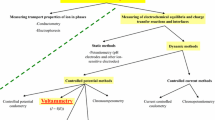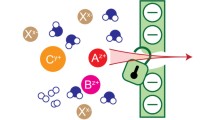Summary
-
1.
In cats under Dial, thirty different anions were injected into some 400 cerebral cortical neurones, by diffusion from micro-electrodes, while observing IPSPs evoked by surface stimulation.
-
2.
The probability of stable intracellular recording was much enhanced when micro-electrodes were filled with an organic salt of K.
-
3.
With the exception of I03 −, all univalent anions tested were capable of producing a reversal of IPSPs in a substantial proportion of cases. IPSPs therefore appear to be associated with a high permeability to many univalent anions.
-
4.
Apart from CrO4 −, multivalent anions only rarely caused a reversal of an IPSP.
-
5.
The probability of observing a reversal with inorganic anions was a very steep function of their relative mobility in water. The relative mobilities through the membrane, calculated on the assumption that the membrane pores have the same permeability at rest and during IPSPs. are consistent with the hypothesis that inorganic anions travel through pores whose equivalent diameter is about twice the diameter of hydrated Cl− and is appreciably greater than that of the corresponding pores in spinal motoneurones.
-
6.
The probability of observing a reversal with organic univalent anions (mainly of aliphatic and aromatic acids) bore an approximately linear relation to their mobility in water. These anions have a much higher mobility through the membrane (during inhibition, and perhaps even at rest) than would be expected from their size if they travel through the same pores as the inorganic anions.
-
7.
As in other membranes, the rate of diffusion of various ions is evidently determined not only by the ions' size relative to membrane pores, but also by their chemical structure and their ability to interact with membrane constituents.
Similar content being viewed by others
References
Albe-Fessard, D., et P. Buser: Explorations de certaines activités du cortex moteur du chat par microélectrodes: dérivations endo-somatiques. J. Physiol. (Paris) 45, 14–16 (1953).
Araki, T., M. Ito and O. Oscarsson: Anion permeability of the synaptic and non-synaptic motoneurone membrane. J. Physiol. (Lond.) 159, 410–435 (1961).
Asada, Y.: Effects of intracellularly injected anions on the Mauthner cells of the Goldfish. Jap. J. Physiol. 13, 583–598 (1963).
Bjerrum, J., G. Schwarzenbach and L.G. Sillen: Stability Constants. Part 1. Organic Ligands. Spec. Pubis, chem. Soc. 6 (1957).
Boistel, J., and P. Fatt: Membrane permeability change during inhibitory transmitter action in crustacean muscle. J. Physiol. (Lond.) 144, 176–191 (1958).
Bouillenne, R.: Pénétration des sels amoniacaux dans les cellules végétales. C.R. Soc. Biol. (Paris) 103, 50–52 (1930).
Coombs, J.S., J.C. Eccles and P. Fatt: The specific ionic conductances and the ionic movements across the motoneuronal membrane that produce the inhibitory post-synaptic potential. J. Physiol. (Lond.) 130, 326–373 (1955).
Creutzfeldt, O.D., H.D. Lux and S. Watanabe: Electrophysiology of cortical nerve cells. In: The Thalamus, pp. 209–235. Ed. by D.P. Purpura and M.D. Yahr. New York: Columbia University Press 1966.
Davson, H., and J.F. Danielli: The permeability of natural membranes. Cambridge: University Press 1943.
Eccles, J.C.: The physiology of nerve cells. Baltimore: The Johns Hopkins Press 1957.
—, R.M. Eccles and M. Ito: Effects of intracellular potassium and sodium injections on the inhibitory postsynaptic potential. Proc. roy. Soc. B 160, 181–196 (1964a).
—: Effects produced on inhibitory postsynaptic potentials by the coupled injections of cations and anions into motoneurons. Proc. roy. Soc. B 160, 197–210 (1964b).
Firth, D.R., and L.J. De Felice: Electrical resistance and volume flow in glass microelectrodes. Canad. J. Physiol. (1968) [in press].
Ginsborg, B.L.: Ion movements in junctional transmission. Pharmacol. Rev. 19, 289–316 (1967).
Goldman, D.E.: Potential, impedance and rectification in membranes. J. gen. Physiol. 27, 37–60 (1943).
Hodgkin, A.L., and B. Katz: The effect of sodium ions on the electrical activity of the giant axon of the squid. J. Physiol. (Lond.) 108, 37–77 (1949).
Höber, R.: The permeability of red blood corpuscles to organic anions. J. cell. comp. Physiol. 7, 367–391 (1936).
Howard, E.: The effect of fatty acid buffer systems on the apparent viscosity of the Arbacia egg, with especial reference to the question of cell permeability to ions. Biol. Bull. 60, 132–151 (1930).
Hutter, O.F., and D. Noble: Anion conductance of cardiac muscle. J. Physiol. (Lond.) 157, 335–350 (1961).
Ito, M., P.G. Kostyuk and T. Oshima: Further study on anion permeability of inhibitory post-synaptic membrane of cat motoneurones. J. Physiol. (Lond.) 164, 150–156 (1962).
Jacobs, M. H.: The exchange of material between the erythrocyte and its surroundings. Harvey Lect. 22, 146–164 (1928).
Katz, B., and R. Miledi: A study of spontaneous miniature potentials in spinal motoneurones. J. Physiol. (Lond.) 168, 389–422 (1963).
Kelly, J.S., K. Krnjević, M.E. Morris and G.K.W. Yim: Ionic permeability of cortical neurones during inhibition. Fed. Proc. 27, 288 (1968a).
—: Anionic permeability of cortical neurones during inhibition. J. Physiol. (Lond.) 196, 120–121 P (1968b).
— and G.K.W. Yim: Unresponsive cells in cerebral cortex. Brain Res. 6, 767–769 (1967).
Kerkut, G.A., and R.C. Thomas: The effect of anion injection and changes in the external potassium and chloride concentration on the reversal potentials of the IPSP and acetyl-choline. Comp. Biochem. Physiol. 11, 199–213 (1964).
Kortüm, G., and J. O'M. Bockris: Textbook of electrochemistry. p. 718. Amsterdam: Elsevier 1951.
Krnjević, K., J.F. Mitchell and J.C. Szerb: Determination of iontophoretic release of acetylcholine from micropipettes. J. Physiol. (Lond.) 165, 421–436 (1963).
—, and S. Schwartz: The action of γ-aminobutyric acid on cortical neurones. Exp. Brain Res. 3, 320–336 (1967).
Landolt-Börnstein: II. Band, 7. Teil. Elektrische Eigenschaften II. 6. Aufl. Berlin-Göttingen-Heidelberg: Springer 1960.
Lanthier, R., and O. Schanne: Change of microelectrode resistance in solutions of different resistivities. Naturwissenschaften 17, 430 (1966).
Li, C.-L., and S.N. Chou: Cortical intracellular synaptic potentials and direct cortical stimulation. J. cell. comp. Physiol. 60, 1–16 (1962).
Lux, H.D., u. M.R. Klee: Intracelluläre Untersuchungen über den Einfluß hemmender Potentiale im motorischen Cortex. Die Wirkung elektrischer Reizung unspezifischer Thalamuskerne. Arch. Psychiat. Nervenkr. 203, 648–666 (1962).
—, and D.A. Pollen: Electrical constants of neurons in the motor cortex of the cat. J. Neurophysiol. 29, 207–220 (1966).
Maizels, M.: The penetration of erythrocytes by anions. Biochem. J. 28, 337–350 (1934).
Neihof, R., and K. Sollner: The physical chemistry of the differential rates of permeation of ions across porous membranes. In: Membrane Phenomena, Discussions of the Faraday Society, No. 21, pp. 95–101. Aberdeen: Aberdeen University Press 1956.
Passow, H.: Ion and water permeability of the red blood cell. In: The Red Blood Cell, pp. 71–145. Ed by C. Bishop and D.M. Surgenor. New York: Academic Press 1964.
Phillips, C.G.: Cortical motor threshold and the thresholds and distribution of excited Betz cells in the cat. Quart. J. exp. Physiol. 41, 70–83 (1956).
Pollen, D.A., and H.D. Lux: Conductance changes during inhibitory postsynaptic potentials in normal and strychninized cortical neurons. J. Neurophysiol. 29, 369–381 (1966).
Purpura, D.P., and R. J. Shofee: Cortical intracellular potentials during augmenting and recruiting responses. I. Effects of injected hyperpolarizing currents on evoked membrane potential changes. J. Neurophysiol. 27, 113–132 (1964).
Renkin, E.M.: Filtration, diffusion and molecular sieving through porous cellulose membranes. J. gen. Physiol. 38, 225–243 (1954).
Robinson, R.A., and R.H. Stokes: Electrolyte solutions. London: Butterworths 1959.
Smith, H.W.: The action of acids on turtle heart muscle with reference to the penetration of anions. Amer. J. Physiol. 76, 411–447 (1926).
Solomon, A.K.: Red cell membrane structure and ion transport. J. gen. Physiol. 43, Suppl. 1, 1–15 (1960).
Stein, W.D.: The movement of molecules across cell membranes. New York and London: Academic Press 1967.
Stewart, D.R.: The permeability of the Arbacia egg to ammonium salts. Biol. Bull. 60, 171–178 (1930).
Svensson, H.: Isoelectric fractionation, analysis, and characterization of ampholytes in natural pH gradients. II. Buffering capacity and conductance of isoionic ampholytes. Acta chem. scand. 16, 456–466 (1962).
Takeuchi, A., and N. Takeuchi: Localized action of gamma-aminobutyric acid on the crayfish muscle. J. Physiol. (Lond.) 177, 225–238 (1965).
—: Anion permeability of the inhibitory post-synaptic membrane of the crayfish neuromuscular junction. J. Physiol. (Lond.) 191, 575–590 (1967).
Werman, R., R.A. Davidoff and M.H. Aprison: Inhibitory action of glycine on spinal neurons in the cat. J. Neurophysiol. 31, 81–95 (1968).
Author information
Authors and Affiliations
Additional information
Wellcome Fellow; on leave from Edinburgh University.
With financial support from the Canadian Medical Research Council and the United Cerebral Palsy Research and Educational Foundation.
Special Fellow (1 FII NB 1680-01 NSRB) of the National Institute of Neurological Diseases and Blindness, U.S. Public Health Service; on leave from Purdue University.
Rights and permissions
About this article
Cite this article
Kelly, J.S., Krnjević, K., Morris, M.E. et al. Anionic permeability of cortical neurones. Exp Brain Res 7, 11–31 (1969). https://doi.org/10.1007/BF00236105
Received:
Issue Date:
DOI: https://doi.org/10.1007/BF00236105




